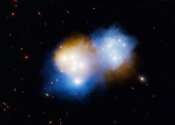In astronomy and cosmology, dark matter is hypothetical matter that is undetectable by its emitted radiation, but whose presence can be inferred from gravitational effects on visible matter. Dark matter is postulated to explain the flat rotation curves of spiral galaxies and other evidence of "missing mass" in the universe. According to present observations of structures larger than galaxies, as well as Big Bang cosmology, dark matter and dark energy account for the vast majority of the mass in the observable universe. The observed phenomena which imply the presence of dark matter include the rotational speeds of galaxies, orbital velocities of galaxies in clusters, gravitational lensing of background objects by galaxy clusters such as the Bullet Cluster, and the temperature distribution of hot gas in galaxies and clusters of galaxies.
Dark matter also plays a central role in structure formation and galaxy evolution, and has measurable effects on the anisotropy of the cosmic microwave background. All these lines of evidence suggest that galaxies, clusters of galaxies, and the universe as a whole contain far more matter than that which interacts with electromagnetic radiation: the remainder is frequently called the "dark matter component," even though there is a small amount of baryonic dark matter.
The dark matter component has much more mass than the "visible" component of the universe. At present, the density of ordinary baryons and radiation in the universe is estimated to be equivalent to about one hydrogen atom per cubic meter of space. Only about 4% of the total energy density in the universe (as inferred from gravitational effects) can be seen directly. About 22% is thought to be composed of dark matter. The remaining 74% is thought to consist of dark energy, an even stranger component, distributed diffusely in space. Some hard-to-detect baryonic matter is believed to make a contribution to dark matter but would constitute only a small portion. Determining the nature of this missing mass is one of the most important problems in modern cosmology and particle physics. It has been noted that the names "dark matter" and "dark energy" serve mainly as expressions of human ignorance, much like the marking of early maps with "terra incognita."
The vast majority of the dark matter in the universe is believed to be nonbaryonic, which means that it contains no atoms and that it does not interact with ordinary matter via electromagnetic forces. The nonbaryonic dark matter includes neutrinos, which were discovered to have mass in recent years, and may also include hypothetical entities such as axions, or supersymmetric particles. Unlike baryonic dark matter, nonbaryonic dark matter does not contribute to the formation of the elements in the early universe ("big bang nucleosynthesis") and so its presence is revealed only via its gravitational attraction. In addition, if the particles of which it is composed are supersymmetric, they can undergo annihilation interactions with themselves resulting in observable by-products such as photons and neutrinos ("indirect detection").
Nonbaryonic dark matter is classified in terms of the mass of the particle(s) that is assumed to make it up, and/or the typical velocity dispersion of those particles (since more massive particles move more slowly). There are three prominent hypotheses on nonbaryonic dark matter, called Hot Dark Matter (HDM), Warm Dark Matter (WDM), and Cold Dark Matter (CDM); some combination of these is also possible. The most widely discussed models for nonbaryonic dark matter are based on the Cold Dark Matter hypothesis, and the corresponding particle is most commonly assumed to be a neutralino. Hot dark matter might consist of (massive) neutrinos. Cold dark matter leads to a "bottom-up" formation of structure in the universe while hot dark matter results in a "top-down" formation scenario.
Important as dark matter is believed to be in the universe, direct evidence of its existence and a concrete understanding of its nature have remained elusive. Though the theory of dark matter remains the most widely accepted theory to explain the anomolies in observed galactic rotation, some alternative theories such as MOND and TeVeS have been proposed. None of these alternatives, however, have garnerned widespread support in the scientific community.









